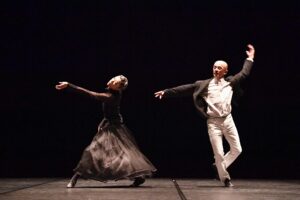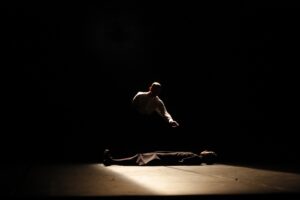The national premiere of The Idiot by the Japanese choreographer and dancer Saburo Teshigawara (Tokyo, 15 September 1953), Golden Lion for Lifetime Achievement at the 2022 Dance Biennale, was staged last April 9th at Teatro Arena del Sole in Bologna, as part of the CARNE – focus on physical dramaturgy programme curated by Michela Lucenti. The show, inspired by Fyodor Dostoevsky’s masterpiece, was conceived ten years ago during a stay in Italy by the founder of the Karas company, founded in 1985 with the aim of searching for “a new form of beauty” in total freedom, a direction that still guides the work of one of the most influential groups in Japanese contemporary dance. The artist, who is also the author of the scenes, costumes and lights in his performances, interprets dance as a complex art, made not only of movement, but also of image and space. The unique style that distinguishes him is the expression of a method that arises from a rigorous discipline aimed at refining a widespread ability to listen to the body, through which it, purged from the contingency of things, becomes capable of intercepting its authentic propensity. According to this thought, which we could define as a sort of sensitive minimalism, the starting point must be a full sensorial perception within a living space, in constant transformation like the human being. In dance the body, open to any event, moving from moments of enchanted suspension to states of capillary animation in which each of its molecules seems to vibrate in favor of the music, models the space through a movement which, going beyond its limits, reveals the quality of a living and simultaneous space. Therefore not the imitation of an external form, but looking through the form at the dynamics of things to come into contact with their intensity and return it through the filter of subjectivity of the interpreter freed from the pre-existences.

Saburo Teshigawara, “The Idiot”, ph Akihito Abe, produzione Karas con il supporto di Agency for Cultural Affairs of Japan
Based on these principles, the interpretation of the Russian novel that entitles the performance is also based more on the incorporation of sensations, images, suggestions and emotions transmitted by the words rather than on adherence to the narrative dimension. The direct transposition is therefore replaced by the restitution of an indirect understanding in a dramaturgy that makes the body speak in harmony with the light and the music. Regarding the elaboration of the pas de deux staged in Bologna, danced with the historic collaborator Rihoko Sato, the artist declared: «I was aware of the impossibility of creating a dance work starting from this literary masterpiece; however, this difficulty was the key to approaching and creating something completely new. A dance that can only exist here. Without any use of the text, a piece of pure dance. Not only impersonating the character linked to the original text, but the embodiment of the movement existing within the words. Silent voices that are heard between the words, screams and moans, murmurs and whispers everything becomes movement and dance. Coming from inside and moving the body. The dance of a life in movement in the form of a human body. A body without answers that continues to question life through continuous movement. The power of silent voices and a noisy body are the structure of the entire work. The Idiot told by the body and not by words».

Saburo Teshigawara, “The Idiot”, ph Akihito Abe, produzione Karas con il supporto di Agency for Cultural Affairs of Japan
On stage, therefore, only two characters, Prince Lev Nikolàevič Myškin and the woman he loved, Nastàs’ja Filippovna, immersed in a deep shadow area from which from time to time the bodies emerge in symbiosis with a light that seems to make them born as well as expressive presences. The music by Claude Debussy, P.I.Tchaikovsky, Oval, Frédéric Chopin, Nocturnal Emissions, Dmitrij Shostakovich, Franz Schubert, John Balance, Peter Christopherson, Drew McDowall, The Beloved, Geir Jenssen, Beequeen, Johann Sebastian Bach and Giuseppe Tartini set their movements , who don’t need any props to relate to the story. In Saburo Teshigawara’s works, light is a presence like the body which, in addition to activating the interpreters by crossing them and structuring them as architecture, atmosphere, dynamics and reverberation, has real moments of pictorial autonomy, very evident here in the passages between one act and another. The show is, in fact, composed of a sequence of scenes that summarize the existential stages of the protagonist, whose center of gravity can be identified in his fluctuating relationship with the woman. The centrality of the protagonist’s gaze, in harmony with what happens in the novel, is the filter through which everything that happens on the stage acquires its reason for existence, as it is underlined by the flickering light, which subtly refers to his suffering from epilepsy and the instability of his thinking.

Saburo Teshigawara, “The Idiot”, ph Akihito Abe, produzione Karas con il supporto di Agency for Cultural Affairs of Japan
It is not essential, in this show, to recognize which episodes of the text refer to the different “frames of impression” in which it is divided, the succession of which reflects, rather than specific incursions into its plot, the sensations aroused by the reading of its crucial points. The choreographer, pulverizing the structure of the story, probes in depth the suggestions generated by the words, almost regardless of the psychological or narrative identification of the characters. On stage, therefore, only fragmentary hints of events occur, such as the first meeting between the two, the prince’s nightmares, a difficult relationship with a jacket which, once removed, refuses to be worn again, the incursion of a big mouse and the vision of Nastasya dead shortly before the finale. These quotes taken from the novel (of which, not surprisingly, Teshigawara favors passages without dialogue between the characters) become events that shape the dancers from within. Through their movements, the two draw the consequences in space, trying to convey them on a universal level.

Saburo Teshigawara, “The Idiot”, ph Akihito Abe, produzione Karas con il supporto di Agency for Cultural Affairs of Japan
Beyond the impossible reconstruction of the plot starting from such fleeting narrative suggestions, what emerges is a sort of parable of the life of the human being in general, alternately dominated by joy, anger, despondency, passion, pain and, finally, loneliness. Throughout the piece Rihoko Sato twirls around Teshigawara barely touching the ground on tiptoe (and her legs compete for lightness and elasticity with the lightning flashes of her black silk dress), while the latter absolutizes with extraordinary mastery (if you think about his age) a varied range of expressive languages to convey the essence of the feelings evoked. At times his body seems to dematerialize, without ever losing its structure, to simultaneously pursue every trickle of background musical polyphony, in other cases it becomes stylized like that of a marionette, while in others he hovers in flight revealing his training as a classic dancer. This search for absolute authenticity, which requires the spectator to have an equally all-encompassing commitment in order not to lose the thread and the involvement, was in my opinion partly betrayed by the choice to use a recorded soundtrack instead of a live orchestra, a choice which inevitably brings all the previous work back to precisely that level of fiction and artifice from which it seemed firmly intent on emancipating itself.
Graduated in art history at DAMS in Bologna, city where she continued to live and work, she specialized in Siena with Enrico Crispolti. Curious and attentive to the becoming of the contemporary, she believes in the power of art to make life more interesting and she loves to explore its latest trends through dialogue with artists, curators and gallery owners. She considers writing a form of reasoning and analysis that reconstructs the connection between the artist’s creative path and the surrounding context.






NO COMMENT